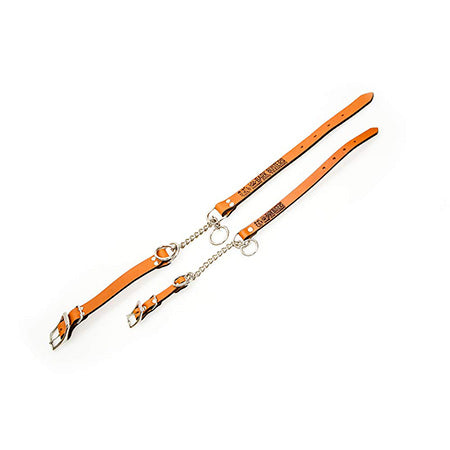








Bark Busters Leather "Communication' Training Collar is one of the best training collars on the market. The kind and gentle way to train your dog. The collar is ideal to help to stop your dog from pulling on the lead. Unlike conventional flat collars the Bark Busters Leather Training Collar uses sound to communicate to your dog where he should walk.
With a quick "flick and release" motion the zip sound of the chain educates your dog to walk by your side.
The Bark Busters training collar has helped thousands of owners gain control of their dogs and to enjoy the walks.
Available in five sizes. The collar should be around 4" larger than the circumference of your dog's neck. See below for Suggested Guidelines for Sizing & Use:
| Size | Width | Length |
| Extra Small | 9mm - 3/8" | 12" - 15" |
| Small | 16mm - 5/8" | 14" - 17" |
| Medium | 19mm - 3/4" | 17" - 20" |
| Large | 25mm - 1" | 19" - 23" |
| X Large | 25mm - 1" | 23" - 26" |
| XX Large | 25mm - 1" | 26" - 29" |
Suggested Guidelines for Sizing and Use
The specially designed Bark Busters training collar is a good way to communicate with your dog and help him understand what it is you want him to do when walking with him. Like all tools, the collar must be used properly in order for it to be safe and most effective.
NOTE: The training collar is to be used for training/walking purposes only. Never leave it on your dog after completing your lead work. In addition, the collar should be used only with a flat lead and not with a retractable lead.
These instructions are meant to provide you with reminders about the proper use of the collar when walking with and training your dog. If you are unsure or uncomfortable about your use of the collar for any reason, please contact us at www.globaldogcompany.com.au.
- When unclipped, the collar should be around 4" larger than the circumference of your dog's neck. If the collar is too large, it will slip over your dog's head; if too small, it will not deliver the correct sound
- To put the collar on your dog.
- Hold the chain part of the collar in your hand on the side of your body that you want to have your dog walk, with the Bark Busters logo on top (closest to you)
The image below is for walking on your right.

The image below is for walking on your left.

- Call your dog to you and, with him facing you, slip the collar over his head.
- Position the collar so that the chain runs along the underside of his neck.
- Clip the lead to the bottom 0-ring. This is the mobile ring next to the metal buckle of the collar.
- Let the weight of the clip and chain position the collar so the ring naturally hangs loosely below your dog's chin.
- If the ring moves around to the back of your dog's head, use the lead to gently reposition the collar with an upward movement of your hand-don't use your hand or bend over your dog to reposition the collar.
- Once your collar is sized properly and the lead is clipped onto the collar, walk your dog around inside your home and practice the "Flick and Release" which is a quick but gentle tug on the lead. Never yank, choke or drag your dog. Give your dog a few minutes to get used to the feel and sound of the collar.
- While practicing in your home, when you “Flick & Release”, you want the chain to make a quick "zip" sound. Do this as your dog's front legs are even with yours. Immediately, turn left or right (in the opposite direction away from your dog) and encourage your dog to follow you. If your dog looks up at you, immediately reward with praise and/or a treat.
- When you first get outside, don’t go right into your normal walk. Do some practice turns for a few minutes to give your dog some time to learn what you want from him.
- Do not proceed forward if your dog is not responding to you and is pulling hard. Go back inside and practice some more.
- Do not try to HOLD your dog back. If you hold your leash very short and tight, it will put a lot of strain and painful pressure on your dog’s neck.
- Do not leave the collar and/or lead on your dog if he is unsupervised.
- Do not take your dog for long walks if you feel he is not responding to you and is pulling. The collar is a training tool intended to help teach your dog to walk with you which can take time. Your walks should be short and specifically focused on training your dog. For example, three (3) ten minute training walks will be more likely to educate your dog than a 30 minute walk on your normal route.
- We recommend that you do not use extendable/retractable leads with our collar.
- We recommend our collar for dogs of at least 6 months of age or older.

